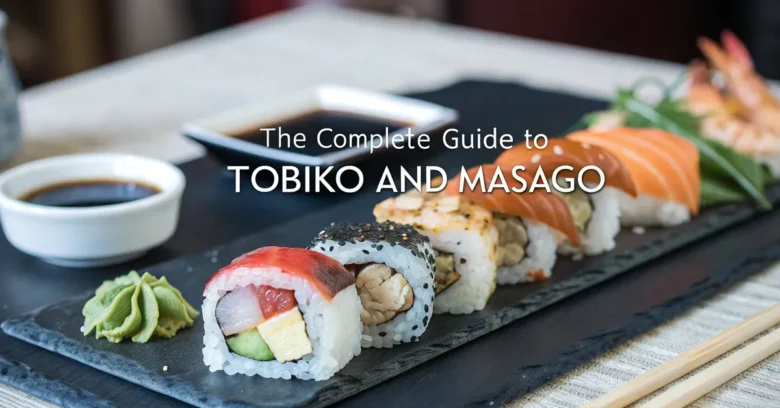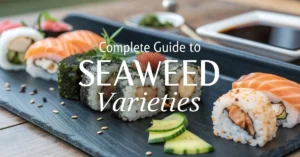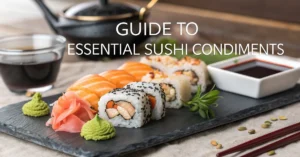Have you ever wondered about those tiny, glistening spheres atop your favorite sushi roll? They’re more than just a pretty garnish. These bursts of flavor, often mistaken for one another, are most likely tobiko or masago – two types of fish roe that add a unique pop to Japanese cuisine.
Navigating the world of sushi ingredients can feel daunting at times, especially when you’re exploring from the comfort of your own kitchen. But fear not! This guide is here to untangle the mysteries of tobiko and masago, helping you understand their differences, similarities, and how to use them to elevate your homemade sushi creations.
Think of this as your comprehensive handbook to mastering these delightful little orbs. We’ll cover everything from their origins and flavor profiles to their nutritional benefits and culinary applications. Get ready to dive deep into the fascinating world of tobiko and masago!
Tobiko and Masago: Unveiling the Secrets of Fish Roe
What is Tobiko?
Tobiko (飛び子) is the Japanese word for flying fish roe. It’s prized for its vibrant color, crunchy texture, and subtly sweet, slightly salty taste. These tiny eggs typically range from 0.5 to 0.8 mm in size, making them slightly larger than masago.
Think of tobiko as the caviar of the fish roe world, due to its more prized nature. It’s often used as a garnish, adding a pop of color and a satisfying burst to sushi rolls, sashimi, and other dishes. Tobiko naturally has a reddish-orange color, but it’s often dyed to create other variations, like black (with squid ink), green (with wasabi), or yellow (with yuzu). These additions not only change the color but also subtly alter the flavor profile.
What is Masago?
Masago (まさご) refers to the roe of the capelin fish, a small member of the smelt family. These eggs are smaller than tobiko, usually around 0.5 mm in diameter. Masago has a milder flavor than tobiko, with a slightly briny and less pronounced sweetness. The texture is also less crunchy, possessing a smoother mouthfeel.
Masago is often dyed bright orange to resemble tobiko, making it a more affordable substitute. It can also be found in other colors, although less commonly than tobiko. Because it’s less expensive, masago is frequently used in large quantities in sushi rolls or as a base for sauces.
Tobiko vs. Masago: Dissecting the Key Differences
While both tobiko and masago are delicious fish roe, here’s a breakdown of their main distinctions:
| Feature | Tobiko | Masago |
|——————-|———————————|———————————|
| Source | Flying fish | Capelin fish |
| Size | 0.5 – 0.8 mm | ~0.5 mm |
| Texture | Crunchy | Smoother |
| Flavor | Sweet, salty, distinct | Mild, briny |
| Color | Naturally reddish-orange, often dyed | Often dyed orange to mimic tobiko |
| Price | More expensive | Less expensive |
Understanding these differences will help you choose the right roe for your culinary needs and preferences. It’s like knowing the difference between different grape varieties when selecting a wine – each has its own unique characteristics!
From Ocean to Plate: Exploring the Journey
Harvesting and Processing
Both tobiko and masago undergo specific harvesting and processing methods to ensure their quality and flavor.
Tobiko Harvesting: Flying fish are typically caught using nets. The roe sacs are then carefully extracted from the fish. Next, the sacs are gently rinsed and sorted. A curing process follows, often involving salt and other flavorings. This process not only preserves the roe but also enhances its taste. Lastly, the tobiko is often dyed to achieve the desired color.
Masago Harvesting: Capelin are also caught using nets. The roe is extracted and processed similarly to tobiko, involving cleaning, curing, and often dyeing. Due to its smaller size and more delicate nature, masago requires extra care during processing to maintain its integrity.
Sustainability Considerations
As conscious consumers, it’s important to consider the sustainability of the seafood we consume, including tobiko and masago.
Tobiko: The sustainability of tobiko depends on the fishing practices employed. Some flying fish populations are healthy and well-managed, while others may be overfished. Look for tobiko that is certified by organizations like the Marine Stewardship Council (MSC).
Masago: Capelin populations can also be vulnerable to overfishing. Some studies point to the capelin stock as being depleted in the Barents Sea, due to the fish being an important food source for cod. In Canada, the fish is considered Least Concern, but its population is decreasing. Choosing masago from sustainably managed fisheries is crucial. Check for certifications and research the source of your masago to make informed decisions.
The Flavor Spectrum: Decoding the Taste Profiles
Tobiko: A Symphony of Flavors
Tobiko offers a complex flavor profile that tantalizes the taste buds. You can expect:
- Sweetness: A subtle, natural sweetness that balances the saltiness.
- Saltiness: A pleasant, moderate saltiness that enhances the overall flavor.
- Umami: A savory depth that adds richness and complexity.
- Subtle Fishiness: A mild, fresh ocean flavor that isn’t overpowering.
The added flavorings from the dyeing process can further enhance the roe, making it more than just a garnish, but also an element that compliments the main dish.
Masago: A Gentle Introduction
Masago presents a milder, more understated flavor compared to tobiko. Its taste can be described as:
- Briny: A distinct, slightly salty taste of the sea.
- Mildly Fishy: A more subtle ocean flavor than tobiko.
- Slightly Sweet: A less pronounced sweetness than tobiko.
Masago’s gentle flavor makes it a versatile ingredient that complements other flavors without overpowering them.
Taste Test: A Side-by-Side Comparison
To truly appreciate the nuances of each roe, try a simple taste test. Place a small amount of tobiko and masago side-by-side on a spoon. Notice the differences in texture, flavor intensity, and aftertaste. It’s like comparing two different types of sea salt – each has its own unique character!
Beyond Sushi: Creative Culinary Applications
While tobiko and masago are staples in sushi, their culinary potential extends far beyond Japanese cuisine.
Tobiko: Elevating Dishes with Crunch and Color
- Garnish: Sprinkle tobiko on salads, appetizers, or main courses for a pop of color and texture.
- Sauces: Incorporate tobiko into cream sauces, vinaigrettes, or dips for added flavor and visual appeal.
- Canapés: Use tobiko as a topping for canapés or crostini with cream cheese or avocado.
Masago: A Versatile Flavor Enhancer
- Sushi Rolls: Use masago as a filling or coating for sushi rolls, adding a subtle flavor and texture.
- Pasta Dishes: Mix masago into pasta sauces or sprinkle it on top of pasta dishes for a briny kick.
- Salad Dressings: Whisk masago into salad dressings for a unique flavor dimension.
Fusion Cuisine: Blending East and West
Experiment with incorporating tobiko and masago into fusion dishes. Try adding them to tacos, omelets, or even pizza for an unexpected twist. The possibilities are endless!
Nutritional Powerhouses: Health Benefits Unveiled
Beyond their delicious flavor, tobiko and masago offer a range of nutritional benefits.
Key Nutrients
Both tobiko and masago are rich in:
- Protein: Essential for building and repairing tissues.
- Omega-3 Fatty Acids: Beneficial for heart health and brain function.
- Vitamin D: Important for bone health and immune function.
- Vitamin B12: Crucial for nerve function and red blood cell production.
- Selenium: An antioxidant that protects cells from damage.
Health Benefits
Consuming tobiko and masago in moderation can contribute to:
- Heart Health: Omega-3 fatty acids help lower triglyceride levels and reduce the risk of heart disease.
- Brain Function: Omega-3 fatty acids are vital for cognitive function and memory.
- Bone Health: Vitamin D helps the body absorb calcium, promoting strong bones.
- Immune Function: Vitamin D and selenium support a healthy immune system.
Considerations
While tobiko and masago offer numerous health benefits, there are a few considerations to keep in mind:
- Sodium Content: Both roe varieties can be high in sodium, so consume them in moderation, especially if you have high blood pressure.
- Allergies: People with seafood allergies should avoid tobiko and masago.
- Purines: Roe is high in purines, which can exacerbate gout symptoms in some individuals.
Sourcing and Storage: A Guide for Home Cooks
Where to Buy
Tobiko and masago can be found at:
- Asian Grocery Stores: These stores typically offer a wide selection of tobiko and masago, including different colors and flavorings.
- Specialty Seafood Markets: These markets often carry high-quality tobiko and masago from reputable sources.
- Online Retailers: Several online retailers sell tobiko and masago, offering convenience and a wide variety of options.
What to Look For
When purchasing tobiko and masago, look for:
- Freshness: The roe should have a fresh, clean smell and a vibrant color.
- Intact Eggs: The eggs should be firm and intact, not mushy or broken.
- Reputable Brands: Choose brands with a good reputation for quality and sustainability.
Storage Tips
Proper storage is essential for maintaining the quality and freshness of tobiko and masago:
- Refrigeration: Store tobiko and masago in an airtight container in the refrigerator.
- Temperature: Keep the temperature consistent, ideally between 32°F and 38°F (0°C and 3°C).
- Shelf Life: Consume tobiko and masago within a few days of opening for optimal flavor and texture.
The Art of Preparation: Tips and Tricks for Perfect Results
Thawing
If using frozen tobiko or masago, thaw it slowly in the refrigerator overnight. Avoid thawing at room temperature, as this can compromise the texture and flavor.
Enhancing Flavor
To further enhance the flavor of tobiko or masago, try marinating it briefly in soy sauce, mirin, or sake before using it in your dishes.
Handling
Handle tobiko and masago gently to avoid crushing the delicate eggs. Use a light touch when mixing or incorporating them into other ingredients.
Recipe Inspiration: Tobiko and Masago in Action
Tobiko Sushi Rolls: A Crunchy Delight
Ingredients:
- Cooked sushi rice
- Nori seaweed sheets
- Your favorite sushi fillings (e.g., avocado, cucumber, crab sticks)
- Tobiko
- Soy sauce (optional)
- Wasabi (optional)
Instructions:
- Place a nori sheet on a bamboo sushi rolling mat.
- Spread a thin layer of sushi rice over the nori sheet.
- Arrange your chosen fillings in the center of the rice.
- Roll the sushi tightly using the bamboo mat.
- Slice the roll into bite-sized pieces.
- Top each piece with tobiko.
- Serve with soy sauce and wasabi, if desired.
Masago Pasta: A Briny Indulgence
Ingredients:
- Cooked pasta (e.g., spaghetti, linguine)
- Olive oil
- Garlic, minced
- Red pepper flakes (optional)
- Masago
- Lemon juice
- Fresh parsley, chopped
- Salt and pepper to taste
Instructions:
- Heat olive oil in a pan over medium heat.
- Add garlic and red pepper flakes (if using) and sauté until fragrant.
- Stir in masago and cook for a minute.
- Add lemon juice and parsley.
- Season with salt and pepper to taste.
- Toss the cooked pasta with the masago sauce.
- Serve immediately.
Tobiko and Masago Salad: A Colorful Medley
Ingredients:
- Mixed greens
- Cherry tomatoes, halved
- Cucumber, sliced
- Avocado, diced
- Tobiko
- Masago
- Your favorite salad dressing
Instructions:
- Combine mixed greens, cherry tomatoes, cucumber, and avocado in a bowl.
- Sprinkle with tobiko and masago.
- Drizzle with your favorite salad dressing.
- Toss gently and serve.
Frequently Asked Questions: Addressing Your Curiosities
Can I substitute tobiko for masago and vice versa?
While you can substitute masago for tobiko to save money, the textures and flavor profiles will not be the same. Tobiko will give your dish a more “popping” texture, and masago can sometimes be virtually unnoticeable.
Are tobiko and masago safe to eat?
Yes, tobiko and masago are safe to eat when sourced from reputable suppliers and stored properly. Be mindful of potential allergens and sodium content.
How can I tell if tobiko or masago is fresh?
Fresh tobiko and masago should have a clean, sea-like smell and a vibrant color. Avoid roe that smells fishy or looks dull.
Your Journey into Fish Roe Delights: A Final Bite
From the subtle differences in taste and texture to their diverse culinary uses, tobiko and masago add a unique touch to any dish. Whether you’re crafting a platter of sushi for you and your friends, or want to experiment in your kitchen, the possibilities are endless.
So, which fish roe is worth it? Tobiko has much more value to the dish, in terms of flavor and texture. Masago can sometimes make a great alternative, since it is more budget-friendly. It ultimately falls to your preferences, and you are the one to decide if you want to elevate the dishes you create!



